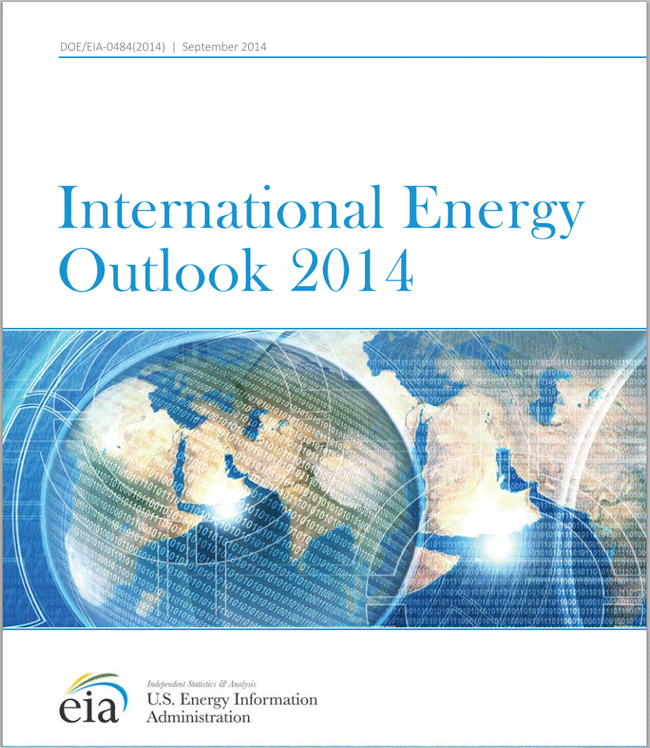

INTERNATIONAL ENERGY OUTLOOK 2014
Release Date: September 9, 2014 | Next Release Date: September 2015 (SEE RELEASE CYCLE CHANGES) | Report Number: DOE/EIA-0484(2014)
Overview
International Energy Outlook 2014 cover.World markets for petroleum and other liquid fuels have entered a period of dynamic change—in both supply and demand. Potential new supplies of oil from tight and shale resources have raised optimism for significant new sources of global liquids. The potential for growth in demand for liquid fuels is focused on the emerging economies of China, India, and the Middle East, while liquid fuels demand in the United States, Europe, and other regions with well-established oil markets seems to have peaked. After a long period of sustained high oil prices, improvements in conservation and efficiency have reduced or slowed the growth of liquid fuels use among mature oil consumers. The changes in the overall market environment have led the U.S. Energy Information Administration (EIA) to focus on reassessing long-term trends in liquid fuels markets for the 2014 edition of its International Energy Outlook (IEO2014).
IEO2014 projections of future liquids balances include two broad categories: crude and lease condensate and other liquid fuels. Crude and lease condensate includes tight oil, shale oil, extra-heavy crude oil, field condensate, and bitumen (i.e., oil sands, either diluted or upgraded). Other liquids refer to natural gas plant liquids (NGPL), biofuels (including biomass-to-liquids [BTL]), gas-to-liquids (GTL), coal-to-liquids (CTL), kerogen (i.e., oil shale), and refinery gain.
After the oil crises of the 1970s and 1980s, much of the debate about world oil markets centered on the limitations of supply. Energy security was (and remains) a major concern, with large resource deposits located in and controlled by members of the Organization of the Petroleum Exporting Countries (OPEC). In addition, strong increases in demand for oil and a limited supply response to rising prices in the mid-2000s led to increasingly vocal concerns about resource depletion. More recently, with higher sustained world oil prices—by historic measures—and advances in extraction technologies, growing supplies of tight oil and shale oil in the United States have brought new resources to market, beginning in North America and, eventually, in other parts of the world. There is also hope that recent legislative changes in Mexico will reverse that country's recent trend of slowly declining oil production. Outside North America, the potential for large production increases in Brazil, Argentina, and elsewhere could help ensure the availability of liquid fuels supplies for many years.
Prices
The benchmark oil price used in IEO2014 is based on spot prices for North Sea Brent crude oil, which is an international standard for light sweet crude oil. The West Texas Intermediate (WTI) spot price and the North Sea Brent price diverged in 2011 to a high of around $30 per barrel, with Brent the more expensive oil. The spread eventually decreased in 2013 and 2014 as a result of new crude pipeline construction and crude pipeline flow reversals in the United States. EIA expects the WTI-Brent discount to continue to decrease over time and will continue to report WTI prices (a critical reference point for the value of growing production in the U.S. Midcontinent), as well as the imported refiner acquisition cost (IRAC). The recent decision by the U.S. Commerce Department's Bureau of Industry and Security to allow exports of some lease condensates after processing also has the potential to further reduce the spread between the Brent price and the price of domestic production streams.
Since July 2012, North Sea Brent prices have generally remained in the range of $100 to $115 (nominal dollars) per barrel. Growing liquids supplies in North America—especially from the United States and also from Canada—have brought more than 4 million barrels per day (MMbbl/d) of additional liquids supplies to market since 2008. However, that increase has largely been offset by supply disruptions in other oil-producing regions, notably in North Africa and the Middle East. EIA estimates that unplanned crude oil production outages have averaged 2.7 MMbbl/d over the past two years and generally have trended upward, from 1.8 MMbbl/d in May 2012 to about 3.5 MMbbl/d in May 2014 [1]. OPEC member countries Libya and Iran and non-OPEC countries South Sudan and Syria have accounted for a sizeable portion of the unplanned outages. It is difficult to predict when the supplies may return, given the significant geopolitical difficulties faced by these producers. This adds considerable uncertainty to the mid-term and long-term projections.
Demand
Demand has also played a role in keeping world oil prices largely stable for the past few years. In countries outside the Organization for Economic Cooperation and Development (non-OECD countries), demand growth has moderated as key economies, including China, India, and Brazil, have seen slower economic growth and correspondingly slower growth in liquids demand compared with the past two decades. Liquids consumption among OECD countries, which reached its peak at 50 MMbbl/d in 2005, has generally been trending downward since that time, reflecting both slow economic growth and growing energy efficiency in the transportation sector.
Key influences on consumption and production are price trends and the reactions of consumers and producers to those trends, which in turn influence future prices. EIA has developed three price cases to examine a range of potential interactions of supply, demand, and prices in world liquids markets: the Reference case and alternative Low Oil Price and High Oil Price cases.





